
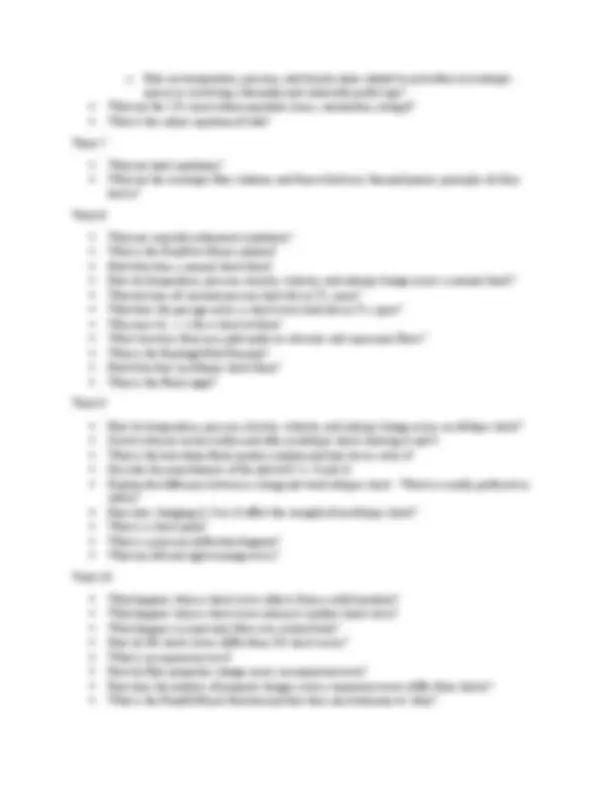

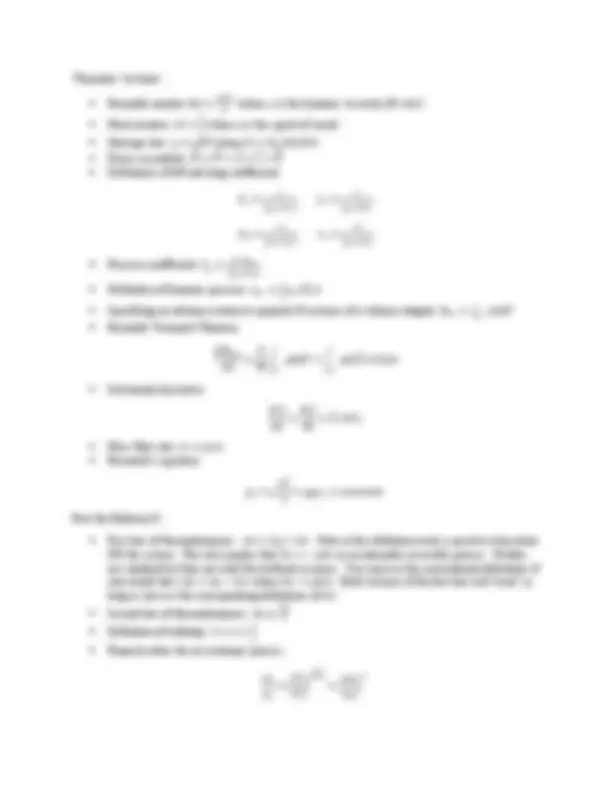
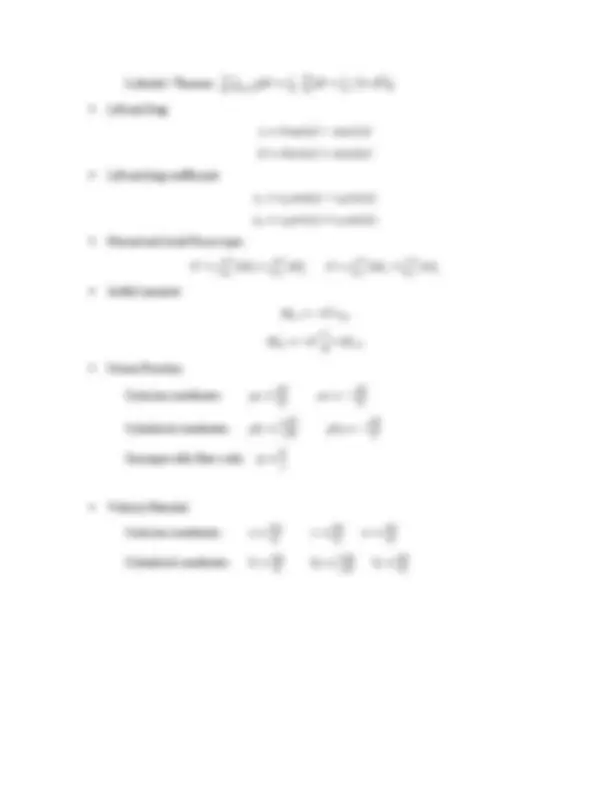
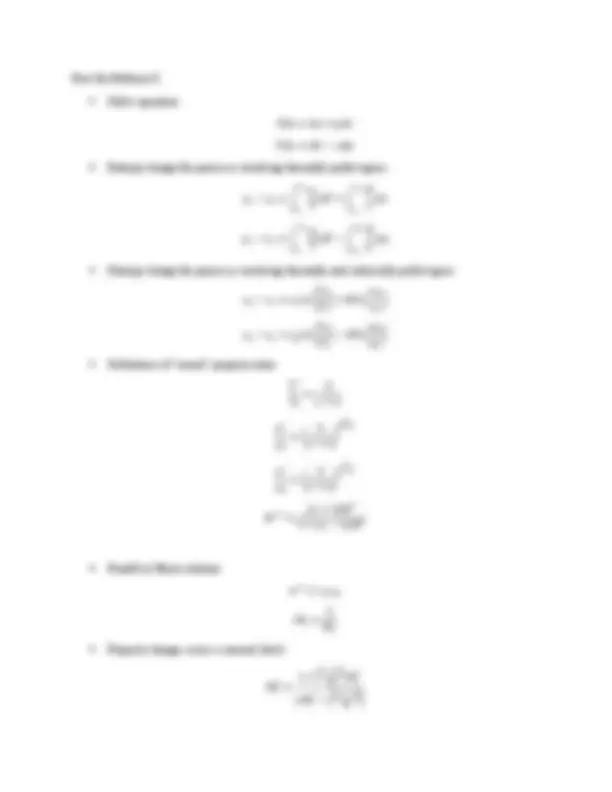
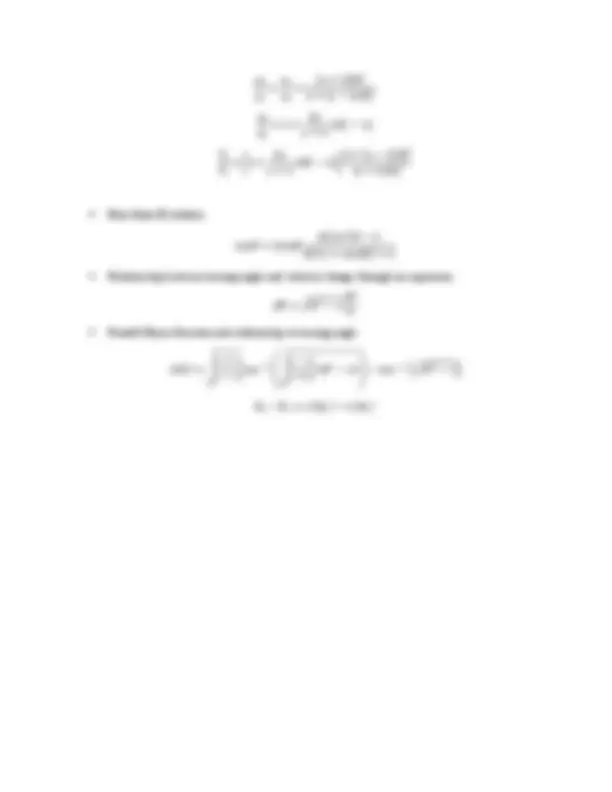


Study with the several resources on Docsity

Earn points by helping other students or get them with a premium plan


Prepare for your exams
Study with the several resources on Docsity

Earn points to download
Earn points by helping other students or get them with a premium plan
Community
Ask the community for help and clear up your study doubts
Discover the best universities in your country according to Docsity users
Free resources
Download our free guides on studying techniques, anxiety management strategies, and thesis advice from Docsity tutors
A comprehensive review of key topics covered in the midterm i exam for the engineering aeronautics and astronautics course enae 311, focusing on fluid mechanics and thermodynamics. The review includes detailed explanations of airfoil attributes, forces, and performance, vector operations, mass and momentum conservation, thermodynamic properties, shock waves, and more. It also introduces new concepts for midterm ii, such as the gibbs equations, entropy changes, and starred property ratios.
Typology: Study notes
1 / 12

This page cannot be seen from the preview
Don't miss anything!







Midterm I Review (2021)
Key topics/concepts:
Week1:
edge, NACA shape, etc.)
Week 2:
problem?
Week 3:
Week 4
entering/leaving a control volume?
Week 5
on a fluid system?
Week 6
o What are thermodynamic properties and how do they differ from thermodynamic states?
o What is internal energy?
o What is enthalpy?
o How are internal energy and enthalpy related to temperature for a thermally perfect gas
and a calorically perfect gas?
o How does one use specific heats to represent internal energy and enthalpy?
o How does one account for temperature variations in specific heats?
o What is the first law of thermodynamics?
o What is the second law of thermodynamics?
o What is an adiabatic process?
o What is a reversible process?
o What is an isentropic process?
o How is work defined for a reversible process?
o How does one calculate the change in entropy associated with a particular
thermodynamic process?
Week 11
‘Formulas’ to know:
𝜌𝜌𝜌𝜌𝜌𝜌
𝜇𝜇
where 𝜇𝜇 is the dynamic viscosity (N-s/m
2
𝜌𝜌
𝑎𝑎
where a is the speed of sound.
𝑢𝑢
𝐿𝐿
𝐿𝐿
1
2
𝜌𝜌
∞
𝜌𝜌
∞
2
𝐴𝐴
𝐿𝐿
𝐿𝐿
′
1
2
𝜌𝜌
∞
𝜌𝜌
∞
2
𝑐𝑐
𝜌𝜌
𝜌𝜌
1
2
𝜌𝜌
∞
𝜌𝜌
∞
2
𝐴𝐴
𝐿𝐿
𝜌𝜌
′
1
2
𝜌𝜌
∞
𝜌𝜌
∞
2
𝑐𝑐
𝑝𝑝
𝑝𝑝−𝑝𝑝
∞
1
2
𝜌𝜌
∞
𝜌𝜌
∞
2
𝐴𝐴
∞
1
2
∞
∞
2
𝐶𝐶𝐶𝐶
𝐶𝐶
𝑠𝑠𝑠𝑠𝑠𝑠
𝐶𝐶
𝐴𝐴
1
1
2
1
New for Midterm II:
ON the system. This also implies that 𝛿𝛿𝛿𝛿 = −𝑝𝑝𝜌𝜌𝑝𝑝 in an internally reversible process. Neither
are standard but they are what the textbook assumes. You may use the conventional definitions if
you would like ( 𝜌𝜌𝑅𝑅 = 𝛿𝛿𝑞𝑞 − 𝛿𝛿𝛿𝛿 where 𝛿𝛿𝛿𝛿 = 𝑝𝑝𝜌𝜌𝑝𝑝). Both versions of the first law will ‘work’ as
long as you use the corresponding definitions of 𝛿𝛿𝛿𝛿.
𝛿𝛿𝛿𝛿
𝑇𝑇
𝑝𝑝
𝜌𝜌
2
1
2
1
𝛾𝛾
𝛾𝛾−
2
1
𝛾𝛾
‘Formulas’ you will be given with BRIEF explanations
Integral form:
𝜕𝜕
𝜕𝜕𝜕𝜕
𝐶𝐶
𝐴𝐴
Differential form:
𝜕𝜕𝜌𝜌
𝜕𝜕𝜕𝜕
Integral, steady 1-D: 𝑚𝑚̇ = 𝜌𝜌
1
1
1
2
2
2
Integral form:
𝜕𝜕
𝜕𝜕𝜕𝜕
𝐶𝐶
𝐴𝐴
𝐴𝐴
𝐴𝐴
Differential form: 𝜌𝜌
𝜌𝜌𝑢𝑢��⃗
𝜌𝜌𝜕𝜕
Integral, steady, 1-D, inviscid, no body forces: 𝑚𝑚̇
2
1
2
2
1
1
𝑥𝑥
Integral form:
𝜕𝜕
𝜕𝜕𝜕𝜕
1
2
𝐶𝐶
1
2
𝐴𝐴
𝐴𝐴
𝐴𝐴
𝐴𝐴
𝑠𝑠ℎ𝑎𝑎𝑎𝑎𝜕𝜕
Differential form: 𝜌𝜌
𝜌𝜌𝐷𝐷
𝜌𝜌𝜕𝜕
Integral, steady, 1-D, inviscid: 𝑚𝑚̇ �(ℎ
2
1
𝑢𝑢
2
2
−𝑢𝑢
1
2
2
2
1
𝑠𝑠
𝐶𝐶
𝑥𝑥
𝑥𝑥
𝑠𝑠
𝑠𝑠
𝑧𝑧
𝑧𝑧
𝑥𝑥
𝑠𝑠
𝑧𝑧
𝑥𝑥
𝑠𝑠
𝑧𝑧
𝑠𝑠
𝑧𝑧
𝑧𝑧
𝑠𝑠
𝑧𝑧
𝑥𝑥
𝑥𝑥
𝑧𝑧
𝑥𝑥
𝑠𝑠
𝑏𝑏
𝑥𝑥
Stokes’s Theorem: ∮
𝑐𝑐
𝐴𝐴
Gauss’s Theorem: ∫
𝐴𝐴
𝐶𝐶
Gradient Theorem: ∫
𝐴𝐴
𝐶𝐶
Leibnitz’s Theorem:
𝑑𝑑
𝑑𝑑𝜕𝜕
𝑅𝑅(𝜕𝜕)
𝜕𝜕𝜕𝜕
𝜕𝜕𝜕𝜕
𝑅𝑅
𝐴𝐴
𝐿𝐿
𝑁𝑁
𝐴𝐴
𝜌𝜌
𝑁𝑁
𝐴𝐴
′
𝑢𝑢
′
𝑇𝑇𝑇𝑇
𝐿𝐿𝑇𝑇
𝐿𝐿
′
𝑇𝑇𝑇𝑇
𝐿𝐿𝑇𝑇
′
𝑢𝑢
′
𝑇𝑇𝑇𝑇
𝐿𝐿𝑇𝑇
𝐿𝐿
′
𝑇𝑇𝑇𝑇
𝐿𝐿𝑇𝑇
𝐿𝐿𝑇𝑇
′
′
𝑐𝑐𝑝𝑝
𝐿𝐿𝑇𝑇
′
′
𝑐𝑐/ 4
′
Cartesian coordinates: 𝜌𝜌𝑢𝑢 =
𝜕𝜕𝜓𝜓
𝜕𝜕𝑠𝑠
𝜕𝜕𝜓𝜓
𝜕𝜕𝑥𝑥
Cylindrical coordinates: 𝜌𝜌𝜌𝜌
𝑟𝑟
1
𝑟𝑟
𝜕𝜕𝜓𝜓
𝜕𝜕𝜕𝜕
𝜕𝜕
𝜕𝜕𝜓𝜓
𝜕𝜕𝑟𝑟
Incompressible flows only: 𝜓𝜓 =
𝜓𝜓
𝜌𝜌
Cartesian coordinates: 𝑢𝑢 =
𝜕𝜕𝜕𝜕
𝜕𝜕𝑥𝑥
𝜕𝜕𝜕𝜕
𝜕𝜕𝑠𝑠
𝜕𝜕𝜕𝜕
𝜕𝜕𝑧𝑧
Cylindrical coordinates: 𝜌𝜌
𝑟𝑟
𝜕𝜕𝜕𝜕
𝜕𝜕𝑟𝑟
𝜕𝜕
1
𝑟𝑟
𝜕𝜕𝜕𝜕
𝜕𝜕𝜕𝜕
𝑧𝑧
𝜕𝜕𝜕𝜕
𝜕𝜕𝑧𝑧
2
1
1
2
1
2
1
2
2
1
1
2
2
1
1
2
1
2
1
2
1
2
2
1
2
2
ν
−
2
−
2
2
1
2
1
Midterm I Formula Sheet
Fall 2021
𝐶𝐶
𝐴𝐴
1
1
1
2
2
2
𝐶𝐶
𝜕𝜕
𝜕𝜕𝜕𝜕
𝐶𝐶
𝐴𝐴
𝐴𝐴
𝐴𝐴
2
1
2
2
1
1
𝑥𝑥
𝐶𝐶
𝐴𝐴
𝐴𝐴
𝐴𝐴
𝐴𝐴
𝑠𝑠ℎ𝑎𝑎𝑎𝑎𝜕𝜕
2
1
2
2
1
2
2
1
𝑠𝑠
𝑥𝑥
𝑥𝑥
𝑠𝑠
𝑠𝑠
𝑧𝑧
𝑧𝑧
𝑥𝑥
𝑠𝑠
𝑧𝑧
𝑥𝑥
𝑠𝑠
𝑧𝑧
𝑠𝑠
𝑧𝑧
𝑧𝑧
𝑠𝑠
𝑧𝑧
𝑥𝑥
𝑥𝑥
𝑧𝑧
𝑥𝑥
𝑠𝑠
𝑏𝑏
𝑥𝑥
𝑐𝑐
𝐴𝐴
𝐴𝐴
𝐶𝐶
𝐴𝐴
𝐶𝐶
𝑑𝑑
𝑑𝑑𝜕𝜕
𝑅𝑅(𝜕𝜕)
𝜕𝜕𝜕𝜕
𝜕𝜕𝜕𝜕
𝑅𝑅
𝐴𝐴
𝐿𝐿
𝑁𝑁
𝐴𝐴
𝜌𝜌
𝑁𝑁
𝐴𝐴
′
𝑢𝑢
′
𝑇𝑇𝑇𝑇
𝐿𝐿𝑇𝑇
𝐿𝐿
′
𝑇𝑇𝑇𝑇
𝐿𝐿𝑇𝑇
′
𝑢𝑢
′
𝑇𝑇𝑇𝑇
𝐿𝐿𝑇𝑇
𝐿𝐿
′
𝑇𝑇𝑇𝑇
𝐿𝐿𝑇𝑇
𝐿𝐿𝑇𝑇
′
′
𝑐𝑐𝑝𝑝
𝐿𝐿𝑇𝑇
′
′
𝐶𝐶/ 4
′
𝜕𝜕𝜓𝜓
𝜕𝜕𝑠𝑠
𝜕𝜕𝜓𝜓
𝜕𝜕𝑥𝑥
𝜓𝜓
𝜌𝜌
(inc. only)
𝜕𝜕𝜕𝜕
𝜕𝜕𝑥𝑥
𝜕𝜕𝜕𝜕
𝜕𝜕𝑠𝑠
𝜕𝜕𝜕𝜕
𝜕𝜕𝑧𝑧
𝑟𝑟
1
𝑟𝑟
𝜕𝜕𝜓𝜓
𝜕𝜕𝜕𝜕
𝜕𝜕
𝜕𝜕𝜓𝜓
𝜕𝜕𝑟𝑟
𝑟𝑟
𝜕𝜕𝜕𝜕
𝜕𝜕𝑟𝑟
𝜕𝜕
1
𝑟𝑟
𝜕𝜕𝜕𝜕
𝜕𝜕𝜕𝜕
𝑧𝑧
𝜕𝜕𝜕𝜕
𝜕𝜕𝑧𝑧